#1780s fashion plate
Text

Fashion Plate, 1786, French.
From Cabinet des modes.
Portraying a woman in a red robe à la turque, white cotton fichu and red hat.
BNF Gallica.
#robe à la turque#1780s fashion plate#fashion plate#1786#french#France#1780s france#1780s#cabinet des modes#bnf gallica#fave
126 notes
·
View notes
Text
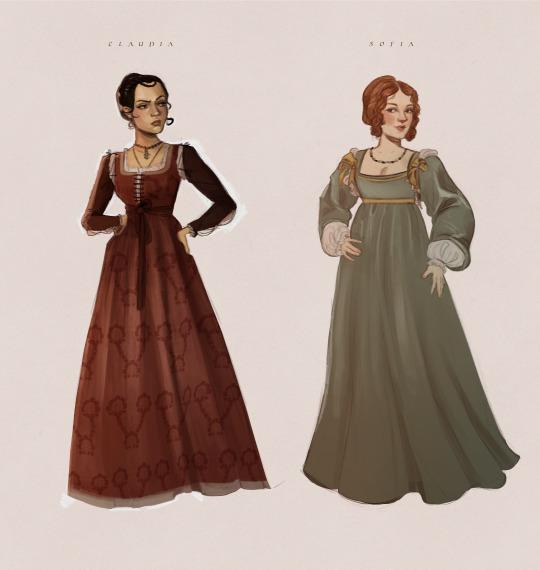
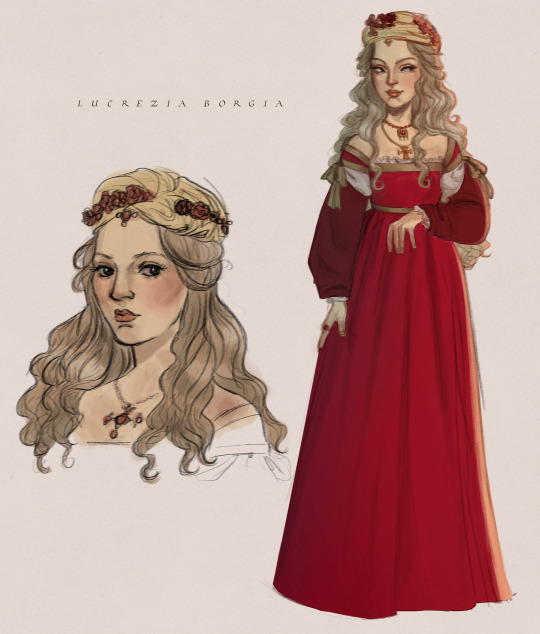
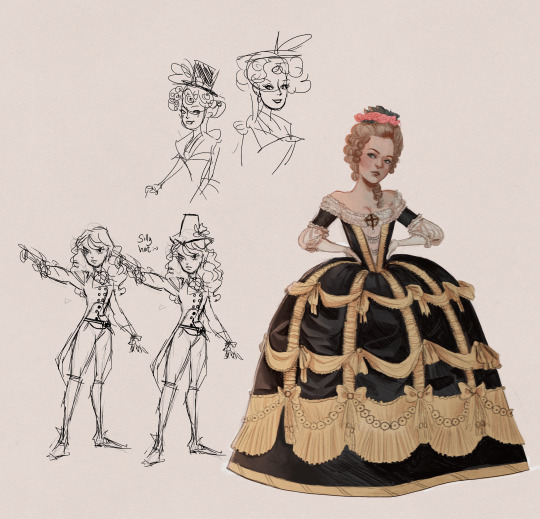
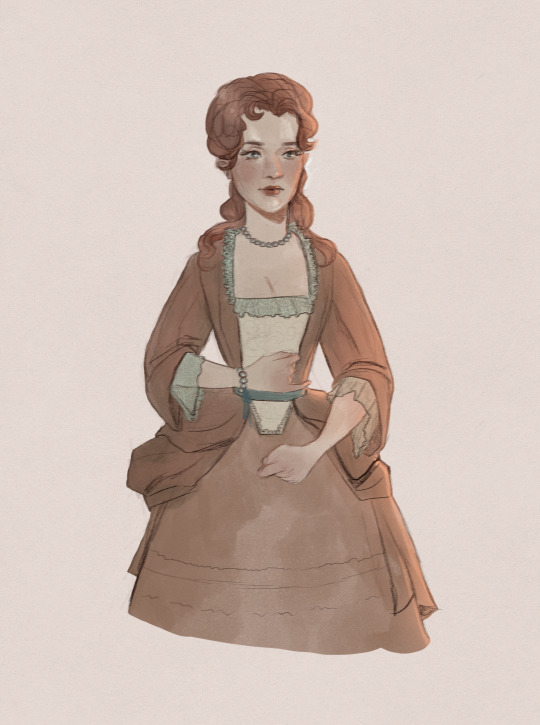
SOME redesigns of assassin's creed women in more historical clothing :> left to right: claudia + sofia from ac 2 and revelations respectively, lucrezia borgia in brotherhood sans 2010s makeup and hair (and cleavage -_-), elise de la serre from unity (the court dress and some other outfit concepts) and caroline from black flag :)
#assassin's creed#claudia auditore#sofia sartor#lucrezia borgia#elise de la serre#caroline scott#ik caroline doesnt actually wear the salmon gown in-game but i hate its existence so. mantua time#she should have her head covered but honestly i forgot :(#also elise!!! i think the ballgown is the worst design ive seen so far sorry but i HATE it. the ballgown is actually real.. from#a fashion plate of the time!! black wasnt common AT ALL but it resembled that mostrosity and from the late 1780s#i also think she'd be into redingotes honestly. forget the stupid line from arno in the beginning where he asks her#why she's wearing a dress ok how would she not#OH btw im aware that the renaissance girls would wear a giornea over this. fashion nerds dont come at me
108 notes
·
View notes
Text
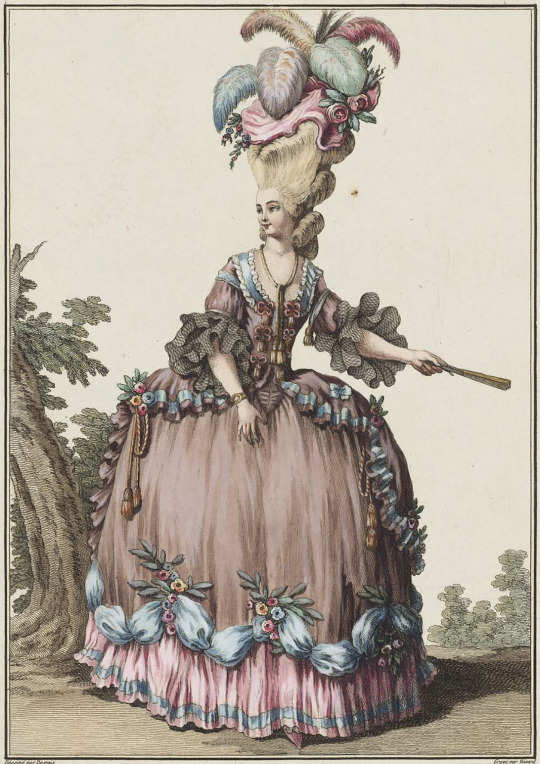
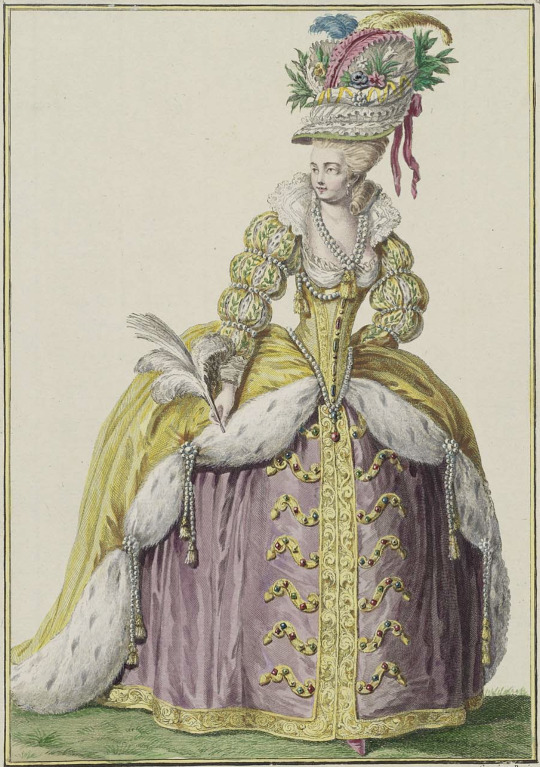
#historical fashion polls#fashion plate#fashion poll#historical dress#historical fashion#dress history#fashion history#18th century costume#late 18th century#18th century fashion#18th century#late 1700s#circa 1780#1770s
45 notes
·
View notes
Text
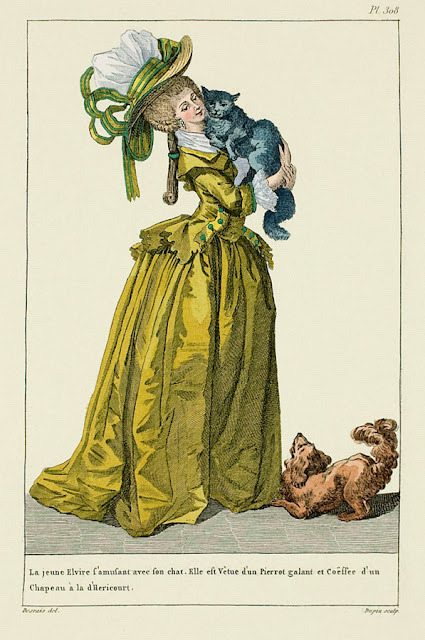
1787
#historical fashion#fashion#historical#history#historical clothing#historical dress#long dress#textiles#textile#1780s#1780s fashion#late 18th century#18th century art#18th century fashion#18th century#rococo#dress#dresses#old fashioned#fashion magazine#high fashion#histocial magazine#magazine#fashion plate#gown#ballgown
30 notes
·
View notes
Text

Planche 1, Cabinet des Modes, May 15th 1786, Bibliothèque Nationale Française.
This plate has a LONG description, and here's a (shortened) rough translation of the description:
We can say it is no longer desirable for women to dress with great adornment (...) and these fashions are no longer made but for ceremonial gatherings, weddings, formal balls, large meals, which take place in very small numbers. This justifies us to not have often representations of these garments (...), nevertheless since they re sometimes worn, we show them in plates 1 and 2.
In plate 1 we can clearly see that we no longer wear the big paniers and even in the most adornment, the fashions have been simplified (except, of course, the court clothes, which do not vary much and can be traces to the clothes of our fathers) (...).
The woman in Plate 1 wears a blue robe à la Turque. The petticoat is of the same fabric and colour, the sleeves are made of white gros-de-Naples or another white fabric. The trim of the dress is in white crepe in the shape of rosettes, and in the middle of each is bouquet of artificial roses. The skirt of also decorated with white crepe and rosettes similar to the dress. The cuffs attached to the sleeves are made of cut white gauze. The throat is covered with a gauze fichu, tied at the front with a rainbow ribbon bow, she wears white leather gloves, and a fan. The head is covered with a bonnet also tied with a rainbow ribbon and topped with a garland of artificial roses. The ribbon forms a large bow at the back and holds a white crepe veil that falls almost to the waist, and on top of the bonnet rises a set of feathers: two rose, two blue, one white, and one green. The hairstyle has light curls along the entire front of the head, her hair is pulled up at the back in a flat bun, and two large curls on each side fall down her length. Her shoes are blue to match the colour of the dress, and are adorned with rainbow ribbon.
I found many funny things in this description, like that the magazine writers thought in 1786 that this look was simple, the concept of rainbow ribbon (ruban à l'Arc-en-Ciel) that seems to simply be a ribbon in colourful stripes, and the size and complexity of that bonnet. How about you? Please let me know in the comments or reblog tags, what is your favorite part of this outfit, or even if you'd like to reproduce it.
Also, the plate 2, that is a men's outfit, will be posted soon :)
#18th century#18th century fashion#cabinet des modes#1780s#1786#france#womenswear#blue#blue womenswear#fashion plate
62 notes
·
View notes
Photo
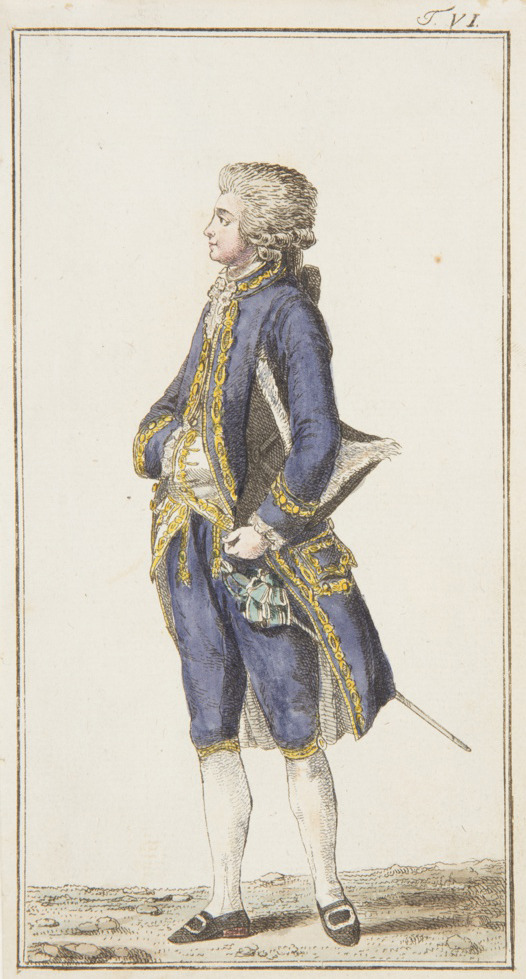



1786 Print, Plate VI, design for gentleman's costume, “Journal des luxus und der moden (Journal of luxury and fashions)”, Vol. 1, No. 2
1789 Print, Plate 16, design for gentleman's costume, “Journal des luxus und der moden (Journal of luxury and fashions)”, Vol. 4, No. 6
1787 Print, Plate 8, design for gentleman's costume, “Journal des luxus und der moden (Journal of luxury and fashions)”, Vol. 2, No. 3
1786 Print, Plate IX, design for gentleman's costume, “Journal des luxus und der moden (Journal of luxury and fashions)”, Vol. 1, No. 3
designed by Georg Melchior Kraus and published by Friedrich Justin Bertuch and Verlag des Landes-Industrie-Comptoirs
(Cooper Hewitt Smithsonian Design Museum)
238 notes
·
View notes
Text

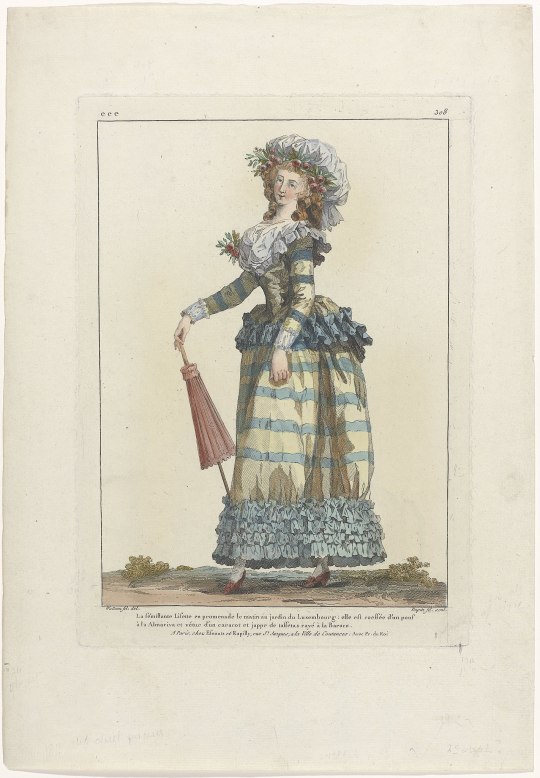


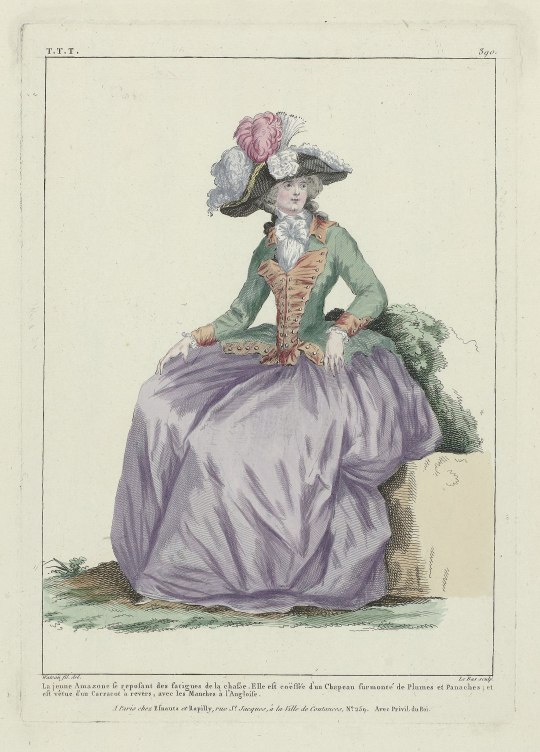
Illustrations of 1780s jacket styles from "Gallerie des Modes et Costumes Français", after Francois-Louis-Joseph Watteau;
"Amazon" after Francois-Louis-Joseph Watteau, circa 1784
"La sémillante Lisett.." after Francois-Louis-Joseph Watteau, 1786
"La Belle Omphale", 1787
"Jeune Nymphe provoquant le plaisir", circa 1787
Le jeune amazone se reposant...", 1787
#Gallerie des Modes#france#1780s#1787#1786#18th century#francois louis joseph watteau#fashion plate#illustration#costume illlustration#18th c. france#mdpillustration
93 notes
·
View notes
Note
Hello! I'm trying to draw something for a friend. Both of our characters live in the late 1720s. They both have regular outfits, but I want to draw them wearing something fancy. My friend has described his character as having a very bad sense of fashion. I can't really picture what a bad outfit back then would look like. Do you?
Hello!
Well I haven't got all that much of a feel for what might have been considered a bad outfit back then, but there is one image that immediately comes to mind of someone who's very definitely badly dressed, and it's this guy. From the 4th panel of Hogarth's Marriage A la Mode (1743-45).

His individual garments look fine to me, but they're horribly mismatched! (And a bit old fashioned for the mid 40's.)
You'll note that the coat cuffs are made of a large brocade that contrasts with the main body of the coat, which was very popular in the first half of the century, but that style was meant to be worn with a matching waistcoat in the same brocade. Instead he's got a completely plain waistcoat that doesn't match at all.
And the breeches should match the main coat fabric, but his don't! The black and brown and beige clash awfully.
He's also got a lot more rings and a much bigger & sparklier earring than I've seen on any other guy from the era, which I speculate might have been tack and/or un-masculine, but I have no sources so don't quote me on that.
I just know that when 18th century guys are wearing rings in a portrait it's usually just one, and I've only ever seen simple little hoop earrings in a very few portraits. But again, emphasis on the "speculate" part of that sentence.
(And I've just noticed that the guy next to him has curling papers in his hair, which I think is probably also meant to make him look silly and not properly dressed. No idea what the opinion would have been about the folding fan dangling from the wrist of the next guy over, but it is intriguing. The very large beauty spot on his lip is probably meant to look bad though.)
That painting is a bit later than what you're asking about, but the style of matching cuffs & waistcoat was popular in the 20's too, so here are some examples of what it's supposed to look like.
A lot of them are very elaborate brocades paired with a solid dark coloured velvet, but sometimes it's a contrasting plain fabric with a ton of metal embroidery.
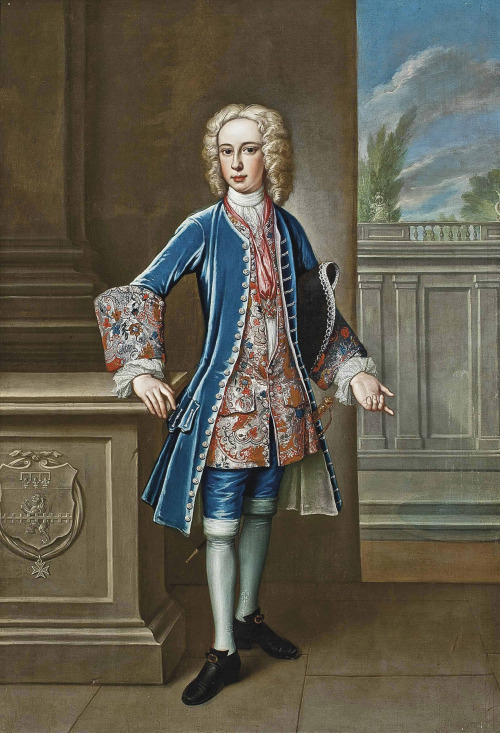
(1725)

(1723)

And an extant c. 1730's example from the NMS collection.
You might also look at 1710's images, because being a decade behind the current fashions would certainly make you badly dressed for the era.

(c. 1715-20)
So, I guess just put them in clashing parts of 2 or 3 different matched suits? (I am assuming you're asking about suits, since this ask was sent to me and I do not know very many things about dresses. Mostly only what I absorb from other costumers who post about it, and barely anyone does early 18th century.)
Please note that this does not apply to the 1780's-90's, fashion plates from those decades are incredibly full of clashing and mismatched suits. (Though it would probably still be bad to wear those ones on a very formal occasion.)
117 notes
·
View notes
Note
can you do 1660s? or 1780s?? thank you!! <3
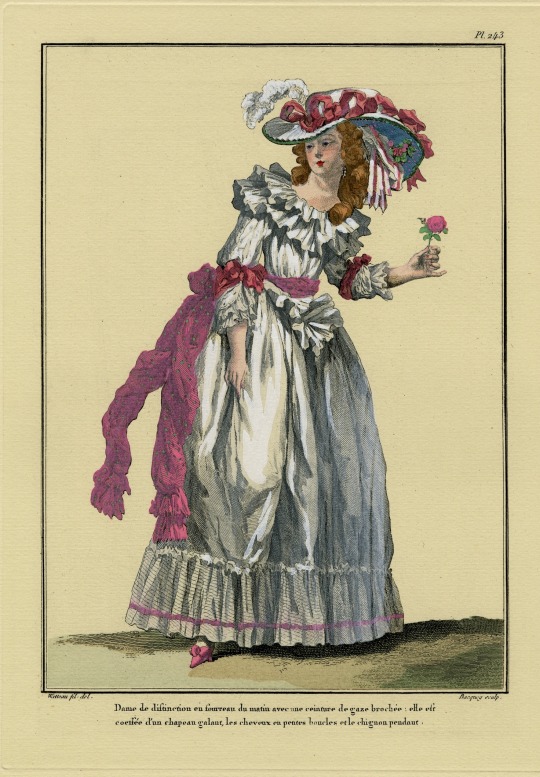
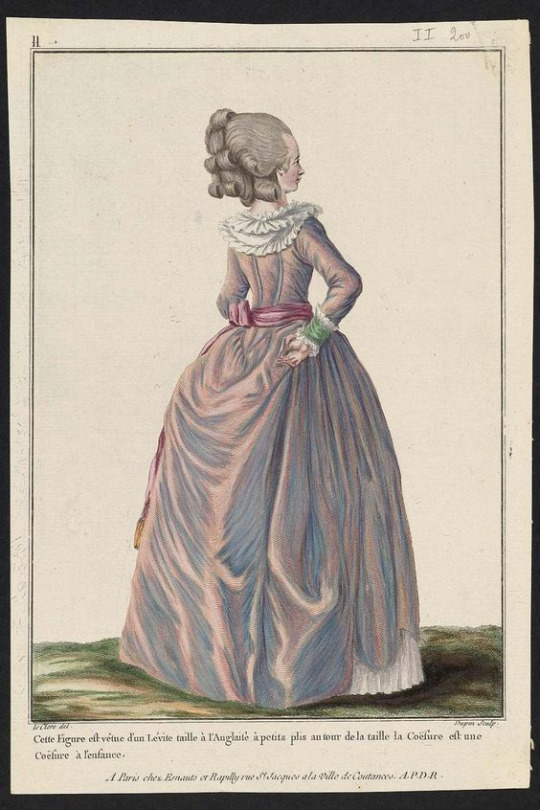
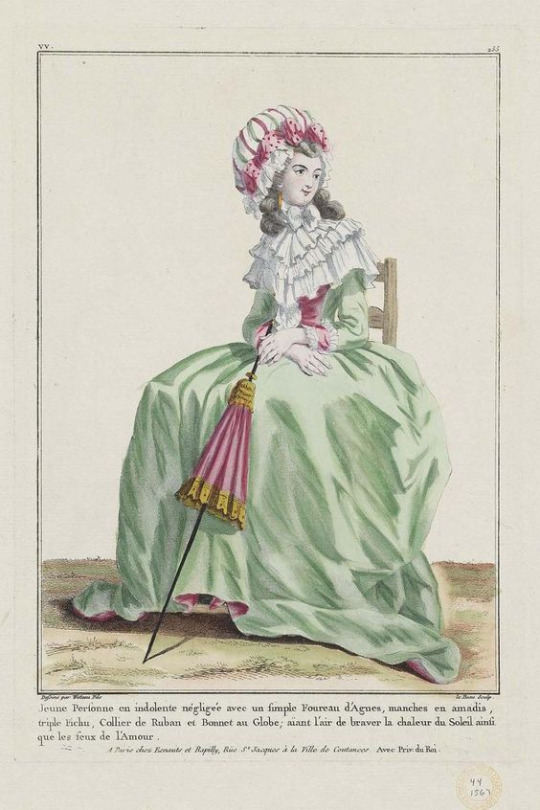
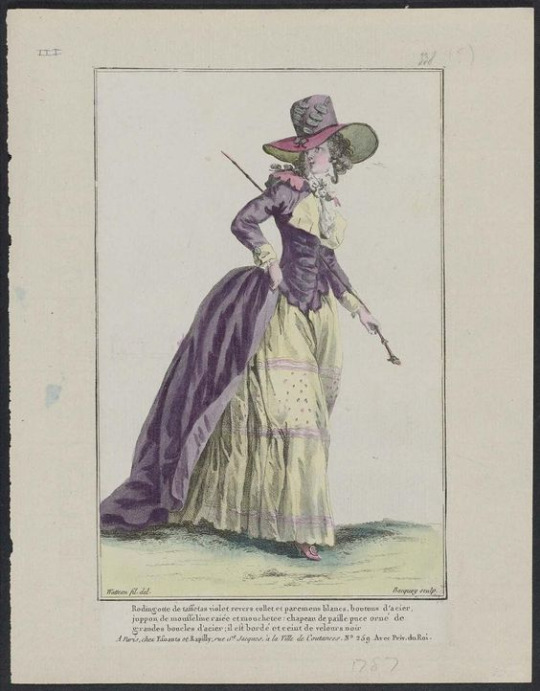


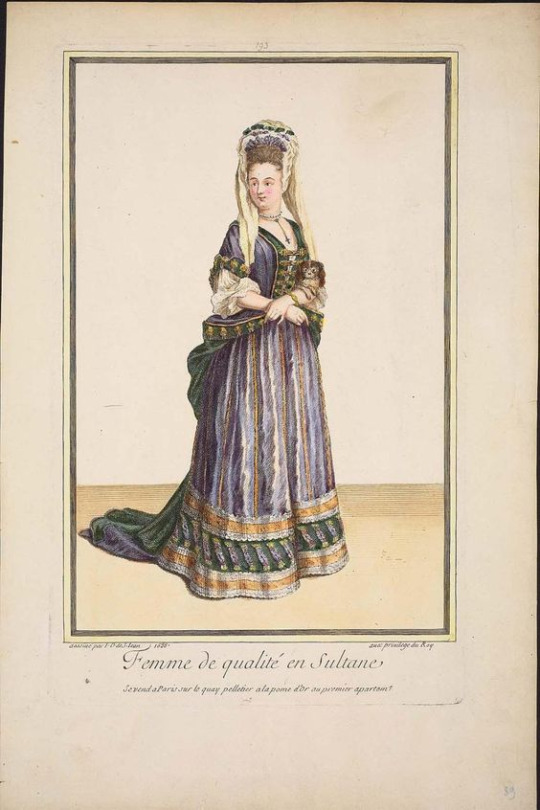
here you go! i managed to find some french fashion plates from the time
86 notes
·
View notes
Text
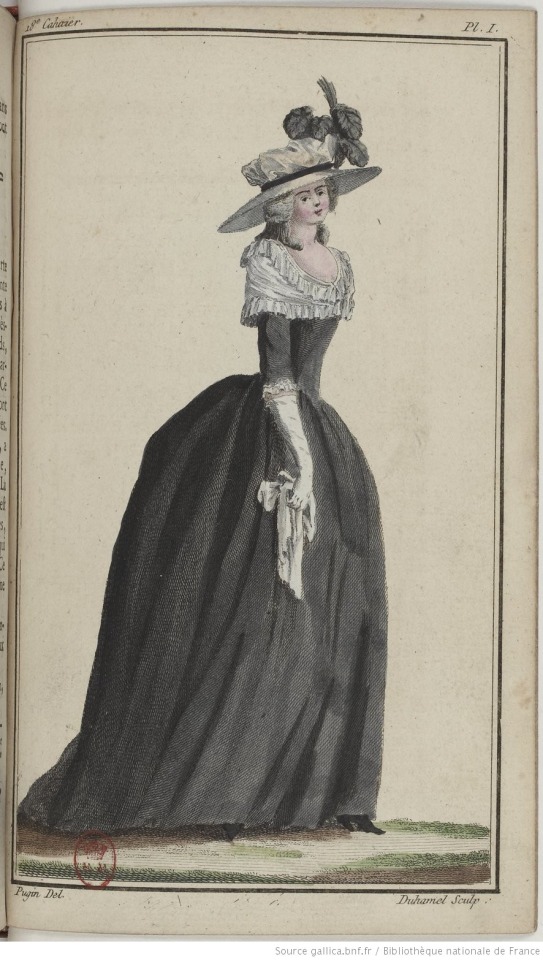
Fashion Plate, 1786, French.
From Cabinet des modes.
Portraying a woman in a black taffeta mourning dress.
BNF Gallica.
#womenswear#france#french#fashion plate#1780s#1780s fashion plate#dress#1780s dress#1786#cabinet des modes#bnf gallica#mourning dress#1780s mourning#mourning#reign: louis xvi
66 notes
·
View notes
Text

Tessa ! Fashion Plates tessa.lapl.org/c03
Over 6,200 hand-colored, finely detailed fashion illustrations produced between 1780 and 1880 for British and American fashion magazines. The plates depict fashionable styles of dress for men, women and children, and constitute valuable source material on the history of dress during this period in history.
3 notes
·
View notes
Text


#historical fashion polls#fashion plate#fashion poll#historical dress#historical fashion#dress history#fashion history#18th century costume#late 18th century#18th century fashion#18th century#1770s#late 1700s#circa 1780
37 notes
·
View notes
Text

1784
#historical fashion#fashion#historical#history#historical clothing#historical dress#long dress#textiles#textile#1780s fashion#1780s#1700s art#1700s fashion#late 1700s#18th century#late 18th century#18th century fashion#18th century art#old fashioned#high fashion#dress#dresses#magazine#histocial magazine#fashion magazine#fashion plate#gown#ball gown#rococo
18 notes
·
View notes
Text
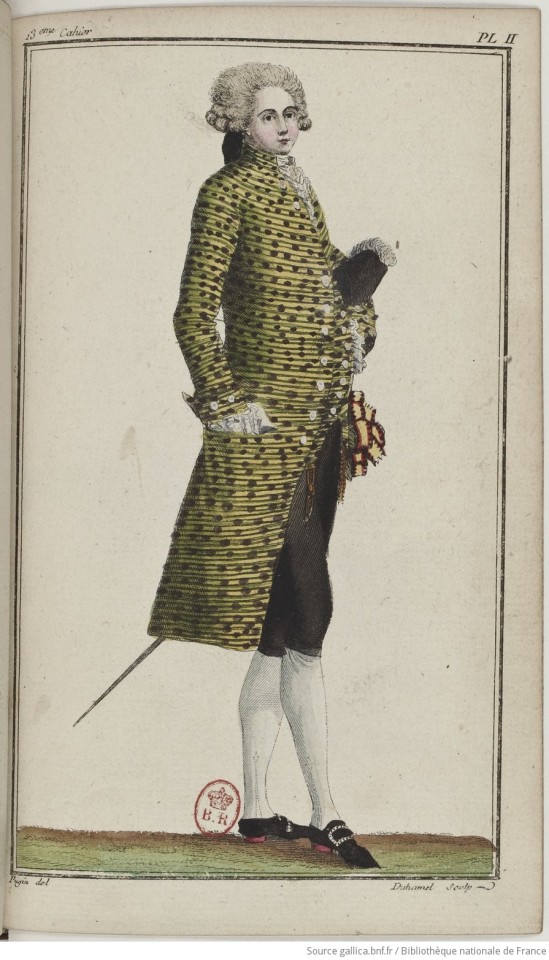
Planche 2, Cabinet des Modes, May 15th 1786, Bibliothèque Nationale Française.
We already looked at the female look for this Cabinet des Modes edition, here we have the male, which I LOVE, because late 18th century menswear is just *chef kiss*. The description is a little shorter than the one for the woman, but here we are in my loose and shortened rough translation:
Plate 2
The coat and waistcoat of the man shown in this plate, are made of spring velvet in a lemon green background with green stripes and lilac spots. The buttons that decorate the coat and waistcoat are enameled and speckled in a contrasting colour. The breeches are made of black liver cloth and the fit is snug/tight. The stockings are white and the shoes have red heels (this fashion is not for everyone) (...). The man wears a white plumed hat on his arms, and lace ruffle on his wrists. He has his left hand in his waistcoat pocket, and his right in his coat pocket.
#18th century#18th century fashion#menswear#green#green menswear#cabinet des modes#fashion plate#1786#1780s#late 18th century
30 notes
·
View notes
Photo
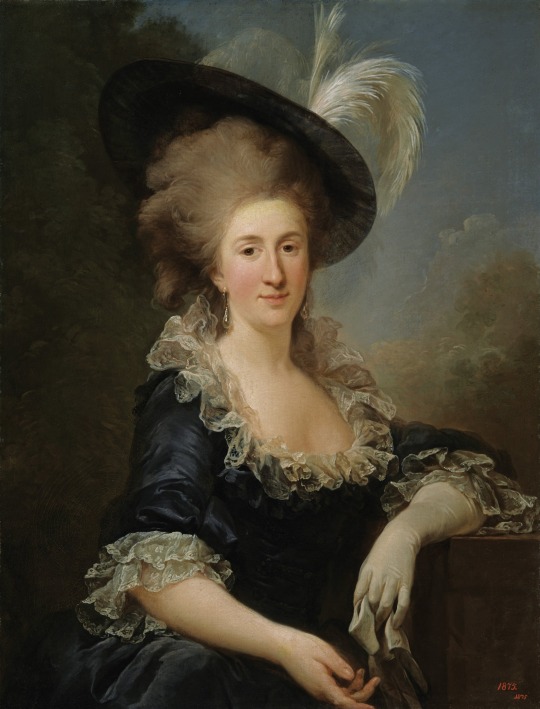



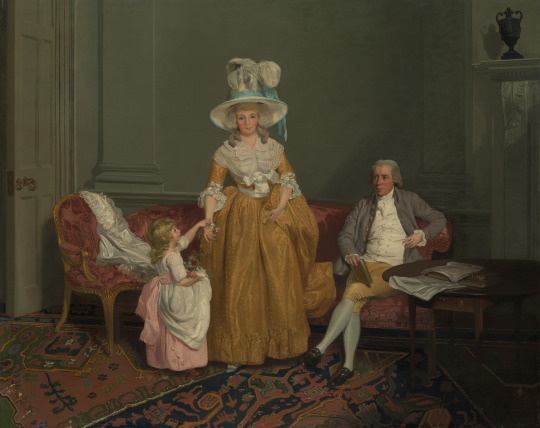


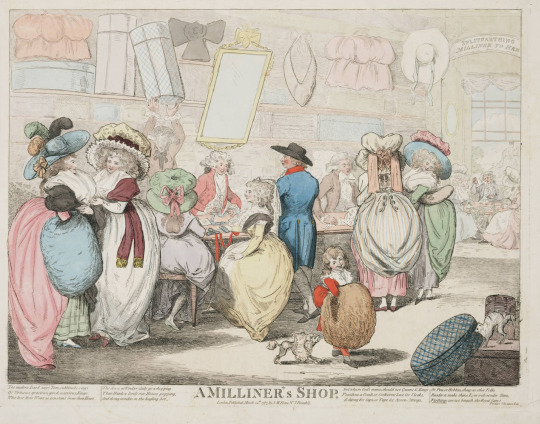
It’s the 1780s
Top: 1780-1783 Anna Teofila Potocka by Marcello Bacciarelli (The Royal Łazienki Museum in Warsaw). From tumblr.com/blog/view/sims4rococo76/675282695253884928 2048X2689 @72 1.3Mj.
Second row left: 1780s Calendar art for February. From tumblr.com/blog/view/sims4rococo76/675282695253884928 750X1063 @72 321kj.
Second row right: Calendar art for April. From tumblr.com/blog/view/antiquelaceartist 750X1063 @72 304kj.
Third row: ca. 1785 Fashion Plate (September) by Robert Dighton (V&A). From tumblr.com/blog/view/silverfoxstole 1916X2500 @72 1.2Mj.
Fourth row: ca. 1785 The Saithwaite Family by Francis Wheatley (Metropolitan Museum of Art). From their Web site 3790X3005 @150 2.9Mj.
Fifth row left: 1785 Maria J. Hoos by Nicolas Joseph Delin (Museum De Lakenhal - Leiden, Zuid-Holland, Netherlands). From tumblr.com/blog/view/andrayblue 2048X2256 @72 989kj.
Fifth row right: ca. 1787 The Mockery by Louis-Léopold Boilly (Wadsworth Atheneum Museum of Art - Hartford, Connecticut, USA). From tumblr.com/blog/view/history-of-fashion 1273X1538 @72 626kj. Mildly cropped.
Bottom: 1787 A Milliners Shop by S. F. Fores. From sfcdyer.wordpress.com/2012/11/26/a-milliners-shop-in-1787/ 1781X1400 @400 891kj. The woman in the center wearing a yellow dress is supposed to be Queen Charlotte.
#1780s fashion#Rococo fashion#Louis XVI fashion#1785 fashion#1787 fashion#Anna Teofila Potocka#Marcello Bacciarelli#Robert Dighton#Saithwaite Family#Francis Wheatley#S. F. Fores#Maria Hoos#Nicolas Joseph Delin#curly hair#bouffant coiffure#long hair#feathered hat#hat brim#U décolletage#bertha#elbow length sleeves#lace cuffs#pleated hat#hat ribbon#three-quarter length sleeves#wrap#apron#maxi-length skirt#shoes#fichu
22 notes
·
View notes
Text
Week 13: Reflection
Initial Challenge: Finding graphic ephemera from a period (just) pre industrial revolution.
Solution: Because fashion was such a large industry in 18th century France, and fashion magazines were essentially invented them, there are many fashion plates from this time.
Initial Challenge: Referencing correctly
Solution: Writing down the authors name, article name, year, in full with all my notes and clearly distinguishing which notes came from which source. When it came to writing my essay with citations, I found it easiest to begin by bullet pointing a rough structure with facts relevant to the paragraph with correct citations, and then building the essay around those.
I have found this course really interesting. In my initial research, I found it a challenge to look for ephemera from my time period. You don’t see many examples of graphic design from the 1780s, as it was so long ago, and just prior the industrial revolution. But, researching from a design rather than a fine arts perspective narrowed my search in unexpected ways and led me down many interesting rabbit holes. I ended up looking at everything from playing cards to caricatures, to crockery design. Ultimately, I landed on fashion plates and fashion as my topic, because fashion plates outnumbered every other design example from the time that I could find. The quantity of fashion plates that came out of this period speaks volumes about how important fashion was at this time, especially in France, which was the European capital of the fashion industry in the late 18th century.
As I refined my search to fashion and fashion publications, I became really fascinated by Marie Antoinette, and was considering focusing my whole essay on Marie Antoinette’s legacy, and the influence of rococo on design throughout history. Ultimately though, I found the transformation design and fashion underwent as the monarchy was abandoned and the republic begun really interesting, and decided to focus my attention here.
Overall, I’ve found this course a good opportunity to learn more about a topic that’s always fascinated me. I was initially nervous about having to read academic texts and reference everything. This is my first time having to use in text citations in an essay, and I feel much more confident now. This course has really opened my eyes to all the information that’s out there if you know where to look. Thanks so much Becky and all the lecturers!
0 notes